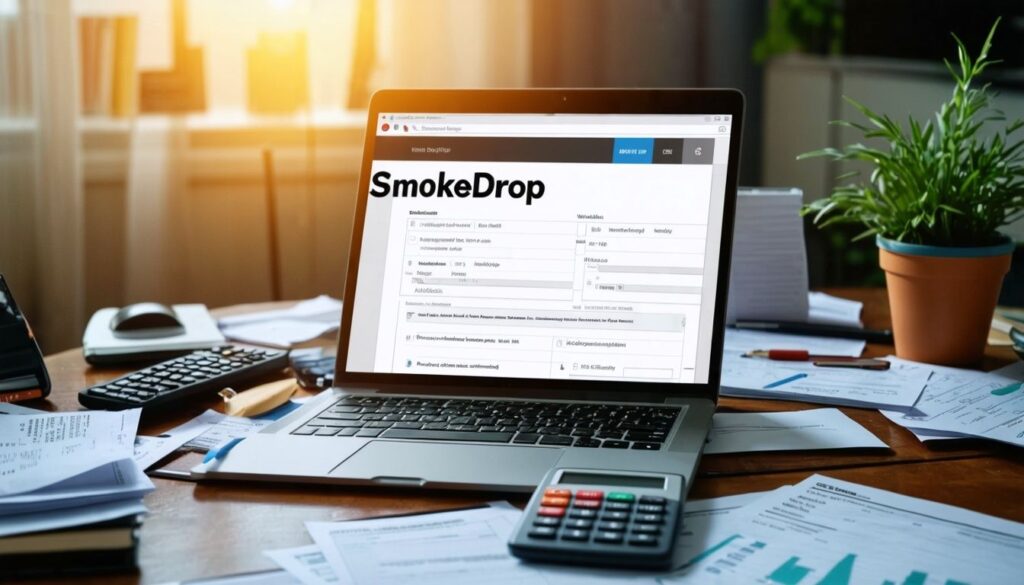Understanding taxes in the dropshipping world can often feel overwhelming for many SmokeDrop app users. A crucial fact to remember is that both income tax and sales tax play significant roles in the financial landscape of a dropshipping business.
This article aims to simplify your tax obligations, focusing on how to navigate and comply with IRS requirements while operating through Shopify. Keep reading to master your ecommerce taxation needs.
Understanding Taxes in Dropshipping
Navigating the world of dropshipping taxes entails understanding income, sales, source, and customs/duty tax requirements. When it comes to managing taxes in dropshipping, clarity on tax payment amounts and when to charge and collect sales tax is crucial.
Types of Tax: Income, Sales, Source, Customs/Duty
Dropshipping with SmokeDrop involves various tax obligations that can affect your business. Understanding these taxes ensures compliance with tax laws and smooth operation of your online retail.
- Income Tax for Dropshippers: This is the tax on the profit you make from your dropshipping business. The IRS requires all businesses, including online ones, to report their income annually. Your business income determines the tax bracket you fall into, affecting how much you owe.
- Sales Tax for Dropshipping: Most states in the U.S require sales tax to be collected on goods sold within their jurisdictions. As a drop shipper using SmokeDrop, you need to know if your business has a physical presence or “nexus” in any state which obligates you to collect sales tax from customers in those states.
- Source Tax: This refers to withholding taxes that may apply when dealing with international suppliers or partners. If your dropshipping business involves transactions outside the U.S., understanding source tax ensures compliance with IRS requirements for reporting payments made to non-U.S entities.
- Customs/Duty Taxes: These are taxes imposed on goods as they enter a country, varying according to the product type and value. When importing products to sell through your Shopify store using SmokeDrop, it’s crucial to factor in customs or duty taxes that may apply upon entry into the destination country, influencing final costs and pricing strategies.
Adhering to these tax responsibilities not only keeps your dropshipping business legal but also positions it for better financial management and growth in the competitive market of online business and small business management.
Navigating Taxes in Dropshipping
Understanding tax obligations is essential for dropshippers to accurately determine how much tax they need to pay and when to charge sales tax. To learn more about managing taxes in dropshipping, delve into the complete guide.
How much tax do you pay?
When it comes to dropshipping, the amount of tax you pay depends on various factors, including your business structure and location. The taxes typically include income tax on profits generated from your dropshipping business, sales tax charged on goods sold within your state or other states where you have nexus, and self-employment tax if you operate as a sole proprietor.
Additionally, customs duties may apply if you’re importing products from overseas suppliers.
Understanding these tax obligations is crucial for complying with IRS requirements and avoiding potential penalties. It’s important to consult with a tax professional to ensure accurate calculation and timely payment of relevant taxes.
When to charge sales tax?
Sales tax should be charged by online sellers when they have a nexus in a state where the customer resides. This can be established through various factors such as having a physical presence, employees, affiliates, or reaching certain sales thresholds within that state.
Once this nexus is determined, it’s crucial to collect and remit the appropriate sales tax to remain compliant with IRS requirements for dropshipping business and avoid potential penalties.
Furthermore, if your ecommerce store has significant sales in states that require tax collection at lower thresholds due to economic nexus laws (which are ever-evolving), you must also charge sales tax accordingly.
Understanding these aspects of when to charge sales tax will ensure compliance with IRS regulations and help in avoiding any undue legal complications related to taxation for your dropshipping business.
How to collect sales tax?
To collect sales tax, the SmokeDrop App User can follow these steps:
- Register for a sales tax permit in each state where they have “sales tax nexus”.
- Determine the correct sales tax rates for each jurisdiction by using a reliable sales tax rate calculator.
- Set up tax collection within the SmokeDrop platform to automatically calculate and add applicable sales taxes to customer orders.
- Keep track of product taxability rules, exemptions, and thresholds specific to each state to ensure accurate tax collection.
- File and remit collected sales taxes to the respective state departments on time.
This ensures compliance with state tax laws and regulations while simplifying the process for both SmokeDrop and its users, promoting smooth operations and avoiding potential penalties or fines.
Managing Taxes with Shopify
Set up automatic tax collection and apply for sales tax exemption certificates, streamlining your tax management with Shopify. Simplify the process to optimize compliance and reduce the risk of common tax mistakes in dropshipping.
Setting up automatic tax collection
To ensure automatic tax collection, SmokeDrop users need to access their Shopify admin dashboard and navigate to the “Settings” section. Then, they should choose “Taxes” and enable the “Automatically calculate taxes” option.
After this, it is essential to input the store’s physical location as well as where sales tax should be collected. This step ensures that the system automatically applies the correct sales tax rates for orders based on buyer location.
Furthermore, users can add nexus states in their Shopify settings, which allows them to specify where they have a significant presence and are therefore liable for collecting sales tax.
By organizing these details accurately within Shopify, SmokeDrop merchants can streamline their tax compliance process while focusing on growing their dropshipping business seamlessly.
Applying for sales tax exemption certificates
Transitioning from setting up automatic tax collection, dropshippers can apply for sales tax exemption certificates to avoid overpaying on taxes. These certificates allow them to make tax-free purchases when sourcing products for their business.
By obtaining these certificates, SmokeDrop users can save on costs and enhance their profitability, ensuring compliance with tax laws while maximizing savings.
Avoiding Common Tax Mistakes in Dropshipping
Avoid common tax mistakes by understanding sales tax nexus and economic nexus. Keeping detailed records is crucial to avoid misclassifying tax rates—a meticulous approach can save time and money in the long run.
Sales tax nexus
In the realm of dropshipping, understanding sales tax nexus is crucial for SmokeDrop users. It determines if a seller has sufficient connection with a state to warrant collecting sales tax.
This connection can be based on factors such as revenue, transaction volume, or physical presence in a particular state. Failing to recognize and comply with sales tax nexus requirements could result in penalties from the IRS and other taxing authorities.
Ensuring compliance with sales tax nexus guidelines is vital for SmokeDrop users seeking to remain IRS compliant and avoid potential penalties. By accurately identifying where they have nexus and adhering to the corresponding tax collection obligations, SmokeDrop users can maintain smooth operations while navigating complex tax regulations in their dropshipping business successfully.
Misclassifying tax rates
Misclassifying tax rates can lead to potential issues with IRS compliance and self-employment taxes for dropshipping. It is crucial for SmokeDrop App users to accurately understand and apply the correct tax rates based on the products being sold.
Misclassification may result in miscalculating tax liabilities, leading to penalties and fines from the IRS. Therefore, ensuring proper classification aligns with understanding dropshipping and complying with tax laws is essential.
Understanding the specific tax brackets and business tax requirements applicable to different product categories in dropshipping can prevent misclassifying tax rates. This knowledge helps SmokeDrop App users navigate complexities within the ever-evolving realm of self-employment taxes, underpinning their compliance efforts while sustaining a successful dropshipping business.
Economic nexus
Transitioning from the topic of misclassifying tax rates, it’s important for SmokeDrop App users to understand economic nexus. Economic nexus refers to the requirement to collect and remit sales tax based on economic activity in a state, regardless of physical presence.
This can be triggered if your dropshipping business exceeds certain thresholds in terms of sales revenue or number of transactions within a particular state. It’s crucial for smoke dropshippers to stay aware of these thresholds, as they vary by state and can impact your tax obligations significantly.
Being knowledgeable about economic nexus is vital for ensuring compliance with various states’ tax laws. Understanding these thresholds and keeping track of your sales activities in different states will help you avoid potential penalties and meet your tax responsibilities as a self-employed dropshipper.
Keeping detailed records
Keeping detailed records is crucial for tax compliance. It helps in tracking expenses, sales, and income related to dropshipping. Detailed records also assist in claiming all eligible deductions, ultimately reducing the taxable income.
Ensuring that all records are accurately maintained will help when it comes to tackling any potential audits or inquiries from the IRS.
By meticulously keeping track of transactions and financial documents, SmokeDrop app users can stay organized and compliant with tax laws while running their dropshipping business.
This approach not only reduces the risk of errors but also provides a clear picture of their financial standing throughout the year.
Conclusion
Understanding and managing taxes in dropshipping is crucial for SmokeDrop App users. Accurately navigating income, sales, source, and customs/duty taxes is key. Setting up automatic tax collection on Shopify can streamline the process.
Avoiding common tax mistakes while keeping detailed records is essential to success in dropshipping with SmokeDrop.
FAQs
1. What does it mean to pay taxes on dropshipping?
Paying taxes on dropshipping with SmokeDrop refers to the process of calculating and paying self-employment tax based on your earnings from this specific business model.
2. How do I calculate my self-employment tax for my dropshipping business?
To calculate your self-employment tax, you’ll need to understand the income generated through your SmokeDrop dropshipping activities. This will form the basis for determining how much you owe in self-employment taxes.
3. Are there any guides available that can help me understand how to pay my taxes when dropshipping?
Yes, is a comprehensive resource designed specifically for individuals seeking clarity about their tax obligations when operating a dropship business via Smokedrop.
4. Is understanding and paying these taxes important if I want to operate a successful dropship business via Smokedrop?
Absolutely! Having a clear understanding of how you’re required to handle self-employment taxes is key part of managing any successful smoke-drop-basedbusinesses legally and ethically.







